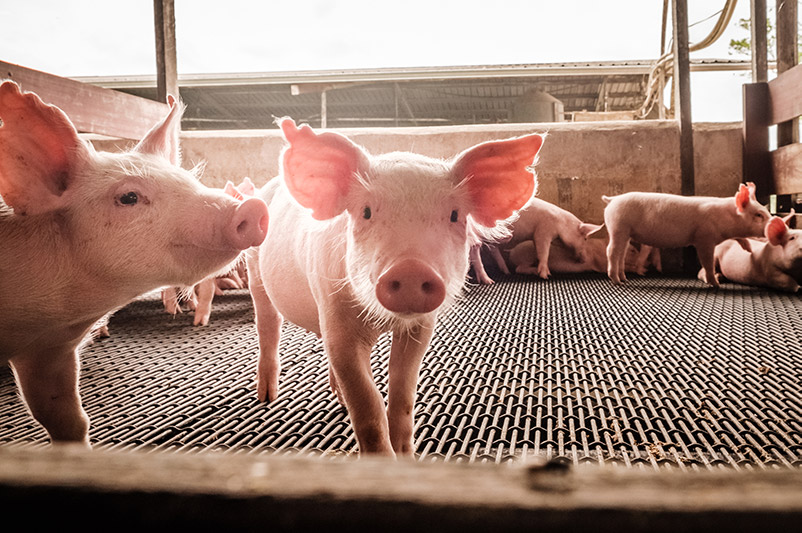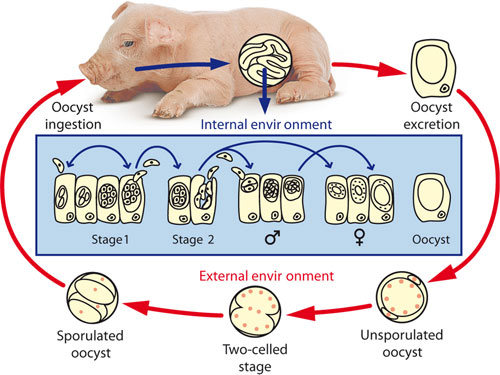Section 2 | Diarrhea in Piglets
Industry
Page 07 /
Pathogens Involved in Diarrhea
Diarrhea in piglets is one of the major health problems affecting swine production today. It can lead to higher death rates1 and reduce growth by 8-14 g per day2. It is estimated that diarrhea costs producers around $200 per sow, per year3. Additionally, as diarrhea is responsible for a significant amount of antimicrobial use in nursery piglets, action needs to be taken with respect to this illness4 to prevent the spread of antimicrobial resistance.
Diarrhea is a complex syndrome and is influenced by the interaction of several factors, including environmental conditions, management practices, pathogen presence, and pig immunity.

Pathogens
There are several pathogens (and mechanisms) that are responsible for causing diarrhea in young piglets including5:
- Clostridium perfringens and Clostridium difficile
- Causes severe damage to the intestine, leading to an impaired ability to absorb nutrients, and secretion of fluid and blood into the intestines
- Enterotoxigenic Escherichia coli
- Produces toxins that cause the intestine to secrete fluid
- Rotavirus, transmissible gastroenteritis, Isospora suis (the organism that causes coccidiosis)

Source: SEGES Svine Production
In Ontario, the occurrence of these pathogens has varied over time, as seen in the figure below6.

The clinical signs and impact of these pathogens can vary depending on which one is involved and how susceptible the piglets are. When diarrhea occurs, due to the rapid loss of fluids and the limited energy reserves that piglets have, they need to receive prompt treatment.
Work with your veterinarian to determine which pathogens are responsible for diarrhea on your farm. With this knowledge, they can help to generate strategic management practices and treatment protocols to mitigate risk.
Work with your veterinarian to determine which pathogens are responsible for diarrhea on your farm
References
- Westin, R., N. Holmgren, J. Hultgren, K. Ortman, A. Linder, and B. Algers. 2015. Post-mortem findings and piglet mortality in relation to strategic use of straw at farrowing. Prev. Vet. Med. 119:141-152.
- Kongsted, H., H. Stege, N. Toft, and J.P. Nielsen. 2014. The effect of new neonatal porcine diarrhea syndrome on average daily gain and mortality in 4 Danish pig herds. BMC Vet. Res. 10:90.
- Sjölund, M., M. Zoric, and P. Wallgren. 2014. Financial impact of disease on pig production. Part III. Gastrointestinal disorders. In: Proceedings of 6th European Symposium of Porcine Health Management, Sorrento, Italy.
- Sjölund, M., A. Backhans, C. Greko, U. Emanuelson, and A. Lindberg. 2015. Antimicrobial usage in 60 Swedish farrow to finish pig herds. Prev. Vet. Med. 121:257-264.
- Larsson, J. 2016. Neonatal porcine diarrhea: Aspects on aetiology and pathology. Doctoral thesis. Swedish University of Agricultural Sciences.
- Chan, G., A. Farzan, J. DeLay, B. McEwen, J.F. Prescott, R.M. Friendship. 2013. A retrospective study on the etiological diagnoses of diarrhea in neonatal piglets in Ontario, Canada, between 2001 and 2010. Can. J. Vet Res. 77:254-260.